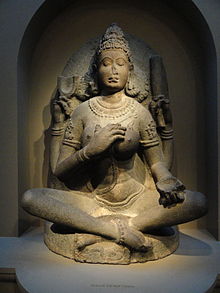Indian art historian and curator
Vidya Dehejia is a retired academic and the Barbara Stoler Miller Professor Emerita of Indian and South Asian Art at Columbia University. She has published 24 books and numerous academic papers on the art of South Asia, and has curated many exhibitions on the same theme.
She has been awarded the Padma Bhushan by the Indian government and a Freer Medal from the Smithsonian's National Museum of Asian Art.
Education
Vidya Dehejia was educated at St. Xavier's College, Mumbai, where she gained a first in ancient Indian culture in 1961. She gained a first in archaeology and anthropology at Newnham College, Cambridge in 1963. She completed her PhD on early Buddhist caves of Western India in 1968, also at Cambridge.[1]
Career
In 1968, she took up a post-doctoral fellowship at the University of Sydney. In 1970 she became a lecturer at the University of Hong Kong. In 1973 she moved to a lectureship at the Delhi School of Planning and Architecture. In 1982 she became an associate professor at Columbia University. In 1994, she moved to the Smithsonian Institution, becoming the chief curator and deputy director of its Freer Gallery of Art and Arthur M. Sackler Gallery. In 2002 she became Barbara Stoler Miller Professor of Indian Art at Columbia University, and in 2003 she became the director of that university's South Asian Institute.[2]
Awards and distinctions
Dehejia was awarded the Padma Bhushan by the Indian government.[3][4][5][6][7]
She has been appointed to the Mario Miranda Visiting Research Professorship at Goa University.[8]
She served on the Humanities jury for the Infosys Prize in 2019.[9]
Dehejia was named the fifteenth recipient of the Freer Medal in 2023, and is the first scholar of South Asian art to receive the award. [10]


